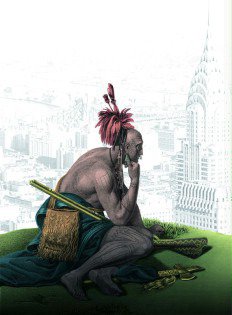On the trails of the Iroquois
dal 16/10/2013 al 5/1/2014
Segnalato da
16/10/2013
On the trails of the Iroquois
Martin Gropius Bau, Berlin
Historical paintings and drawings, ethnographic objects, and extraordinary examples of Iroquois contemporary art tell their checkered history aims to portray this diversity and the Iroquois people's continuous creative adaptations to ever-changing living conditions over time, presenting approximately 500 objects.

curated by Sylvia S. Kasprycki
Bringing together for the first time art and artifacts from major collections in
Europe, the United States, and Canada, the exhibition undertakes a
comprehensive search for the trails of the Iroquois throughout the centuries.
Historical paintings and drawings, ethnographic objects, and extraordinary
examples of Iroquois contemporary art tell their checkered history aims to
portray this diversity and the Iroquois people’s continuous creative adaptations
to ever-changing living conditions over time, presenting approximately 500
objects on about 1.000 square meters of representative exhibition space.
ON THE TRAILS OF THE IROQUOIS attempts to trace the development of
Iroquois culture from its origins up to its vibrant articulations in the present-day
United States and Canada, following their varied history through colonial times
characterized by war, trade, and European missionary efforts; the subsequent
weakening of their power through loss of land and political autonomy and the
eventual break-up of the League after the American Revolution; the cultural
transformations during the Reservation period; and their strive for sovereignty
in the twentieth century up to very contemporary concerns.
Conceived in close cooperation with Iroquois artists, curators, and intellectuals,
the exhibition aspires to a multi-layered representation of both Western
appropriations and imaginings of Iroquois culture as well as contemporary
indigenous voices on their history and present-day identities. As Tuscarora artist
and writer Richard W. Hill expressed it, “it can safely be said that today, the
Haudenosaunee define themselves through their diversity”, as each generation
“adds to that layered definition, taking the artistic expressions of the past, the
oral traditions of their ancestors, and add that to their own life experiences”.
Of the hundreds of Native American peoples, only a few have over the centuries
engaged the European and Euro-American imagination to the extent that the
Iroquois did. This fascination is in a large measure due to the outstanding role
the Five (and later Six) Nations played in the arena of colonial encounters in
seventeenth- and eighteenth-century North America, which gained them a
reputation as fierce warriors and skilled diplomats and is also reflected in a host
of fictional literature. But European interest has always far exceeded this
preoccupation with political and military excellence, and Western intellectual
struggle with Iroquois culture has left enduring imprints not only on the history
of anthropology, but also on popular culture, the peace and women’s
movements, and even efforts to establish the foundation of alternative lifestyles.
As a horticultural people, whose women planted corn, beans and squash on
clearings in the forest and whose men supplemented their diet by hunting and
fishing, the Iroquois lived in villages of bark-covered longhouses occupied by
extended families at the time when the Dutch and French advanced into the
interior of North America in the first half of the seventeenth century. But as
implied in their self-designation “Haudenosaunee”, the Iroquois were ”People ofthe Longhouse” in more than this practical sense: Their intertribal confederation
was likewise metaphorically referred to as a Longhouse, in which the Mohawks
and Senecas assumed the role of Keepers of the Eastern and Western Doors and
the Onondagas were Keepers of the Central Fire; between them, as Younger
Brothers, sat the Oneidas and Cayugas. The founding of the League under the
Great Law of Peace had ended previous intertribal warfare and by uniting the
strengths of the five groups (who were joined around 1722 by the Tuscaroras as
the sixth member) provided the basis for Iroquois territorial expansion and
military ascendancy over their indigenous neighbors.
German Catalogue / Press Copy € 32/ € 15
Head of Corporate Communications / Press Officer
Sven Bergmann
T +49 228 9171–204
F +49 228 9171–211
bergmann@bundeskunsthalle.de
Media Conference: 17 October 2013, 11 a.m., Berlin
Martin-Gropius-Bau Berlin
Niederkirchnerstraße 7 - 10963 Berlin
Opening Hours
Wednesday and Monday 10 a.m. to 7 p.m.
Closed on Tuesday
Admission
standard / reduced €9/€6
Online ticket sales standard / reduced € 10 / € 7



